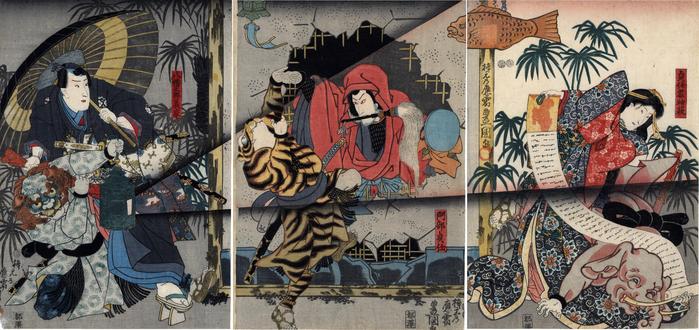Utagawa Kunisada (歌川国貞) / Toyokuni III (三代豊国) (artist 1786 – 01/12/1865)
Imaginary performance (a mitate): actors as Sadatō's wife (tsuma) Sodehagi (貞任妻袖萩) played by Bandō Shūka I on the right, Ichikawa Danjūrō VIII as Abe Sadatō (阿部貞任) in the center, Ichimura Uzaemon XII as Hachiman Tarō Yoshiie (八幡太郎義家) on the left and with a supporting cast as a lion, tiger and elephant
01/1850
9.6 in x 13.5 in (Overall dimensions) Japanese color woodblock print
Signed: Hanmoto no ōju (by special request of the publisher) Toyokuni ga
梓元乃應需豊国画
Publisher: Miyakozawa (Marks U227 - seal 25-446)
Censor seals: Hama and Kinugasa
Library of Congress
Museum of Fine Arts, Boston (right panel)
Hankyu Culture Foundation - right panel
Hankyu Culture Foundation - center panel
Hankyu Culture Foundation - left panel
National Museum of Japanese History (via Ritsumeikan University) - middle panel only Notice that in this Kunisada triptych there are performers dressed up as a stylized lion, tiger and elephant. "Animals were played by actors wearing nuigurumi [縫いぐるみ?] ("sewn-together coverings")." This scene is associated with the play Tomigaoka Ada no Kanegoto (富岡仇兼言) at the Ichimura-za in Edo.
There is no corresponding theatrical performance known.
****
So who were the guys who dressed up as animals... and other stuff about actors
Samuel L. Leiter in "Edo Kabuki: The Actor's World" in Impressions in 2010 on page 122 discussed the hierarchy of actors within the entire kabuki structure. Nidai were the top rank and were given certain privileges reserved just a select few. All of the others were nidaishita or the lower ranks. Nidai literally meant 'title' and nidaishita were 'below title'. "During the Edo period, the principal system of classifying "below title" actors (also called shitamawari, or "going around below") was to divide them into the two categories of chūdori, or "mid-range actors," and shita tachiyaku, or "first-floor male role actor," because of the location of their dressing rooms, but they were also popularly called by several other names, one of which I'll discuss shortly. "First-floor actors of male roles" were extras in crowd scenes, filled in the background in court scenes, cavorted as animals, including being the fore or rear legs of horses, and served as stagehands." [The use of bold type is our choice.]
Later, on page 123, Leiter wrote: "The "below title" female-role specialists, by the way, were not counted among the members of either the third-floor or first-floor "below title" groups; they were segregated into their own dressing room. This was on a level between the first and third floors but, because of regulations against three-story buildings, called the "mid-second floor" (chūnikai), or what might be dubbed the "mezzanine." "Mid-second floor" thus became one of the alternative terms for female- role specialists. From the outside, the theater indicated a two-story building. The logic of having a "third floor" but not a second, as well as the exact architectural arrangements, remain a puzzlement."
"Just as in society at large, there was little or no upward mobility for "below tide" actors. Most were forced to spend their entire lives in the lower ranks." (Ibid.)
"Only a dozen or so Edo actors in the two-hundred-fifty-year period demonstrated enough grit, ambition and talent to rise to "title" status without a star father. A sam- pling includes Kikugorō I (1717-1783), son of an usher; Utaemon I (1719-1791), son of a doctor; Kikunojō IV (1782-1812), son of a teahouse proprietor; and, of course, the only low-ranking actors to become zagashira , Nakazō I, son of either a ronin or a ferry guard, and Kodanji IV (1812-1864), son of a seller of fuse cords for smokers' pipes. In most cases, at least one parent was somehow connected to the theater." (Ibid., pp. 123-124)
****
There are many mitate that operate on many different levels. The history of a beautiful woman sitting on an elephant is one such example. Often it is a courtesan from the Eguchi pleasure district. "The Yūjoki 遊女記 written by Ōe no Masafusa (1041-1111) and dedicated to the history of these women states that the Regent Fujiwara no Michinaga 藤原道長 took an Eguchi courtesan named Ko-Kannon 小観音 ("lesser Avalokitesvara bodhisattva") as his mistress in the years 999-1004..."
****
There was another edition of this triptych that carries the publisher's seal for Matsumura Tatsuemon. We don't know which was first.
actor prints (yakusha-e - 役者絵) (genre)
Bandō Shūka I (初代坂東しうか: from 11/1839 to 11/1854) (actor)
mitate-e (見立て絵) (genre)
Miyakozawa (都沢) (publisher)
Daruma or Bodhidharma (達磨) (role)
Minamoto no Yoshiie (源義家) (role)
Ichimura Uzaemon XII (十二代目市村羽左衛門: 11/1821 to 12/1850) (actor)
Ichikawa Danjūrō VIII (八代目市川団十郎: 3/1832 - 6/8/1854) (actor)
